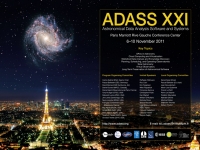Robert Barnsley (Liverpool John Moores University), I.A.Steele (LJMU), R.J.Smith (LJMU)
Abstract
The Liverpool Telescope (LT) is a 2.0 metre robotic telescope that is operating unattended at the Observatorio del Roque de Los Muchachos Observatory on La Palma, Spain. Since robotic operations started in April 2004, the LT has produced data for a variety of science programmes using software and instruments that were designed and developed in-house at the Astrophysics Research Institute of LJMU. Achieving first light in April 2009, the Fibre-fed RObotic Dual-beam Optical Spectrograph (FRODOSpec) succeeded the now decommissioned Meaburn Spectrograph and has been a common user instrument since semester 10A.
FRODOSpec is a bench mounted spectrograph with two optical paths, known as arms, that are utilised by separating the incident light around 5750A into two bandwidths using a dichroic beam-splitter. The light down each arm is collimated, dispersed and focused onto CCDs, with the elements of each optical chain separately optimised for blue and red light. Two dispersive elements are available for each arm: a conventional diffraction grating and a higher resolution Volume Phase Holographic (VPH) grating. The VPH is bonded to a prism so that the light is dispersed at the same angle as the grating, requiring no parts other than the pneumatic stage they are mounted upon to be moved when selecting between them.
To complement the robotic nature of the LT, a fully autonomous data reduction pipeline has been developed for FRODOSpec. Here I describe the process required for the reduction of data taken using an integral field spectrograph and present an overview of the computational methods implemented to create the pipeline. Analysis of errors and future enhancements are also discussed.
Poster in PDF format
Paper ID: P006
Poster Instructions
|

